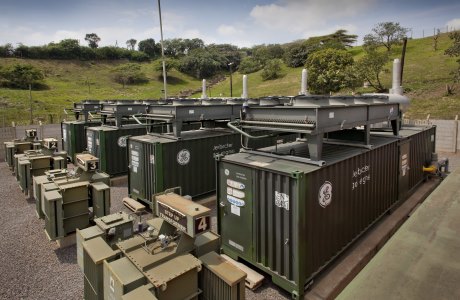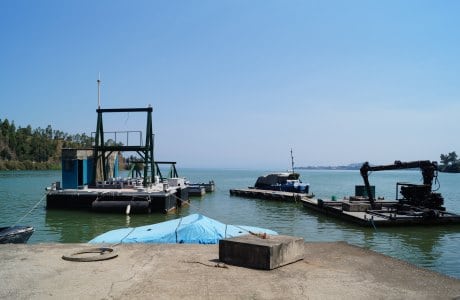When thinking about renewable energy it’s common to think of wind power and solar. However there is massive potential in Africa for the utilisation of renewable gas for power generation. Some naturally occurring microbes are able to break down organic material in the absence of oxygen to produce different types of biologically created gas – ‘biogas’ that consists primarily of methane and carbon dioxide. Renewable energy from biogas has the added benefit of being able to produce a consistent source of power, ‘base-load’, rather than just when the sun shines or wind blows. It can also be utilised for high efficiency combined heat and power generation – giving a useful source of renewable heating or cooling.

Elgin Fruit Juices – Grabouw / W. Cape
The organic material that is required to produce biogas is available in a wide range of forms on the African continent – some uniquely so. This includes biogas from dumpsites – landfill gas, biogas from human waste – sewage gas, biogas from food wastes or agricultural materials and finally naturally occurring biogas, such as that found in lakes in Rwanda and Cameroon, or some mine sites in South Africa.
Biogas is a gas that is formed by a variety of anaerobic microorganisms. These microbes feed off carbohydrates and fats, producing methane and carbon dioxides as metabolic waste products. This gas can be harnessed by man as a source of sustainable energy. Biogas is considered to be a renewable fuel as it originates from organic material that has been created from atmospheric carbon by plants grown within recent growing seasons. Biogas creation is also called biomethanation. Biologically derived gases are produced as metabolic products of two groups of microorganisms called bacteria and Archaea. These microorganisms feed off carbohydrates, fats and proteins, then through a complex series of reactions including hydrolysis, acetogenesis, acidogenesis and methanogenesis produce biogas comprising of carbon dioxide and methane.

Bissar Road, South Africa
The organic component of household waste consists mainly of food waste and paper. When this is sent to a landfill (an engineered dumpsite) and waste reaches a depth of ~10 metres, is compacted and becomes anaerobic. Under anaerobic conditions the microorganisms which create biogas thrive. If the landfill site is correctly designed and managed the resulting landfill gas can be extracted, captured and utilised for power generation. At Bisassar Road in Durban, the gas from the landfill site is extracted and utilised to generate 6.4MW of renewable electricity supplied to the local power grid. In a geographically small country like the UK, Clarke Energy has supplied almost 500MW of landfill gas fuelled power generation equipment.
Food waste from factories or households can be separately collected from other waste streams. The fat and carbohydrate in the waste is a valuable potential source of food for the anaerobic microbes to utilise. An anaerobic digester or biogas plant is a man-made treatment facility for organic material. It typically consists of a reception area, a pre-treatment area to remove contaminants such as paper or plastic, shredders and a series of tanks for the creation of biogas under controlled conditions. As a rule of thumb 20,000 tonnes of food waste per year gives ~1MW of electricity Elgin Fruit in South Africa utilises the fruit pulp left over in the juice production process as a feedstock for anaerobic digestion with a facility that produces 500kW of renewable electricity. Waste materials from the farming industry can also be used in this manner. Tropical Power’s biogas plant near Lake Naivasha in Kenya is able to produce 2.6MW of power from agricultural materials for local utilisation.
In the case of human waste its utilisation for the creation of sewage gas typically relies on the centralised collection of the material through a sewerage system. As human waste has already been digested by a person, a large amount of the carbohydrates and fats have already been utilised. There is also a high water content. This means you need a large amount of human waste to create biogas. Centralised collection and treatment of human waste has the added benefits of improved sanitation and reduced pollution. If the waste water treatment plant includes anaerobic digesters, the biogas formation processes can be artificially harnessed in order to capture and utilise the gas for power generation. In Marrakesh and Fez in Morocco there are a number of sewage treatment works that process human waste for 5.4MW of renewable electricity.

Lake Kivu, Rwanda
The African continent also has highly unusual, naturally occurring sources of biogas, such as that which occurs in the depths of Lake Kivu in Rwanda and the Democratic Republic of the Congo. This lake produces biogas from the combined actions of anaerobic microorganisms at depth feeding off decaying organic matter, alongside processes associated with geothermal activity. In addition other forms of naturally occurring biogas are present in mine sites in South Africa. Archaea are one group of microorganisms that are able to feed off inorganic compounds in the rocks in mine sites to produce high quality biogas. This gas is typically extracted by ventilations systems but has also been flared to help ensure worker safety, but it can also be used as a valuable source of fuel for power generation.
In summary, Africa has vast untapped potential for the utilisation of various different organic and inorganic materials for the production of renewable, decentralised power. In the coming years biogas will play a significant component in the continent’s power generation mix.




